From 1957 to 1965, the Soviet space program was in the lead in rocket payload capacity and spacecraft technology.
With several years of well organized planning before the first Sputnik launch, Soviet scientists surprised the world with a series of increasingly sophisticated missions.
Early Milestones In Spacecraft DesignThe first satellites (Sputnik-1, Explorer-1, Vanguard-1) were small and extremely simple; however, Sputnik-3, Luna-3 and the Vostok spacecrafts were far more complex. With these vehicles, the basic problems of spacecraft design were first encountered and solved. |
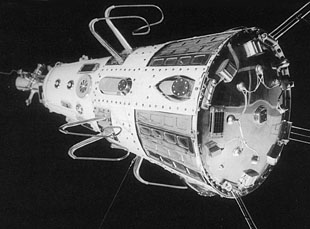 Sputnik-3 (1958)
Sputnik-3 (1958)
|
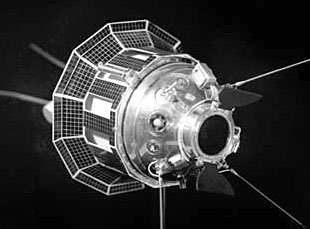 Luna-3 (1959)
Luna-3 (1959)
|
|
Codenamed "Object-D", Sputnik-3 was intended to be the first artificial satellite, when planning of its design and
instrumentation
began in 1955.
An important innovation was active temperature regulation.
Soviet spacecrafts were sealed and filled with slightly pressurized gas, circulated by fans to evenly conduct heat.
Motorized shutters regulated the absorption or reflection of solar heat on the outer hull.
Sputnik-3 was powered by chemical batteries, but it had a solar-powered "Maiak" radio beacon, used for ionospheric plasma studies.
The 1.3 ton spacecraft established a sturdy structural design, with shock resistant instrument blocks attached to a tubular framework of magnesium alloy.
The 435 kilogram (958 pound) Luna-3 was the first truly solar-powered spacecraft, it had the first orientation-control system, and it carried a camera to photograph the far side of the Moon. It was a milestone in spacecraft development, but it lacked the ability to change course, and it did not use a highly directional radio antenna to send its data back to Earth. The thermal control system was based on motorized shutters, like Sputnik-3. During most of its flight, Luna-3 was spin stabilized, on an axis perpendicular to the Sun, so its solar batteries would charge. Early satellites simply tumbled about a random axis, but spinning a spacecraft about a predetermined direction is sometimes preferable. Given small effects like non-rigid antennas and solar wind pressure, spin is only stable around the axis of maximum moment of inertia. For example, America's first satellite Explorer-1 was spun about is lengthwise axis, but its signal began to fade periodically when that motion unexpectedly evolved into an end-over-end tumble.
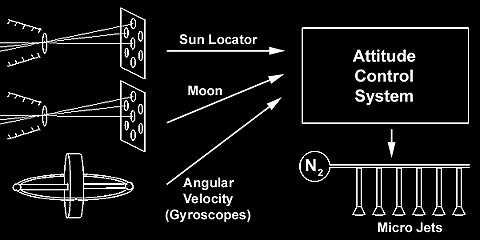
When Luna-3 approached the Moon, it engaged a system of 3-axis stabilization, in order to point its camera. This was the first attitude control system on any spacecraft, and B.V. Raushenbakh's design is essentially still in use. Using optical sensors and pulsed nitrogen microjets, the vehicle first oriented one axis toward the Sun. Then rotating about that axis, it stopped when a sensor next to the camera found the Moon. In an atmosphere, friction has a stabilizing effect on mechanical motion, damping oscillations and slowing objects to a stop when forces are no longer being applied. Without this damping, a feedback control system like Luna-3's would oscillate. Friction enters into the equations of motion as a resisting force that increases with velocity. Raushenbakh simulated friction electronically, by adding angular velocity input from gyroscopes into the control logic. Luna-3 made extensive use of transistorized electronics, at that time a somewhat new technology. A number of the scientific packages in Sputnik-3 also contained solid-state electronics. Contrary to popular myth, Soviet engineers were not limited to vacuum tubes, although they did not eschew them. Vacuum tubes had some superior characteristics (linearity, low noise, high dynamic range, heat and radiation resistance). Russian transistors were manufactured by NPO Svetlana in Leningrad, beginning in 1955.

Vostok Spacecraft (1960) The world's first maneuverable spacecraft was the 4700 kilogram Vostok vehicle, first tested in May 1960, and launched with Iurii Gagarin on April 15, 1961. When filled with camera equipment, it served as the Zenit surveillance satellite. The cylindrical rocket engine is essentially the same module as the Luna upper stage and the Molniia escape stage. Vostok was designed by O.G. Ivanovskii, and its attitude control system by Raushenbakh. Project MV and Venera-1In 1959, Korolëv decided to attempt to reach Mars during the orbital opportunity in the Fall of 1960, and to reach Venus in early 1961. Program MV had only one year for massive preparations, including the construction of the 4-stage Molniia launch vehicle, and the 300 million kilometer range Pluton telemetry system on the Crimean peninsula.Gleb Iu. Maksimov, a brilliant young department head in OKB-1, designed two probes. Object 1M would fly by Mars, and 1V would land on Venus. These were the first spacecrafts to include all the essential elements necessary for a long-range planetary mission: 1M was a cylindrical Mars probe, about a meter in diameter and weighing 480 kg. It was designed to carry the Luna-3 camera, infrared and ultraviolet spectrometers, micrometeorite detectors, ion traps, a magnetometer and cosmic-ray detectors. The camera may have looked out through a porthole on the end or a window on the side. Two 1M probes were lost in launch mishaps in October of 1960. Well past the optimal launch date, the camera, UV spectrograph and IR spectrometer had been removed to reduce weight. Some reports indicate even the vernier engine was removed. Had the mission proceeded according to plan, they were scheduled to perform course corrections in March, jettison their vernier engines, and encounter the planet in May. |
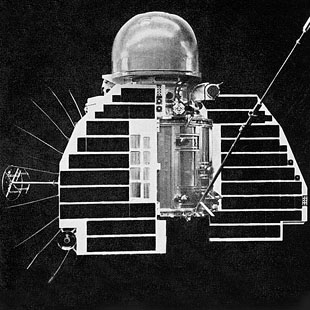 Venus Probe 1VA (front)
Venus Probe 1VA (front)
|
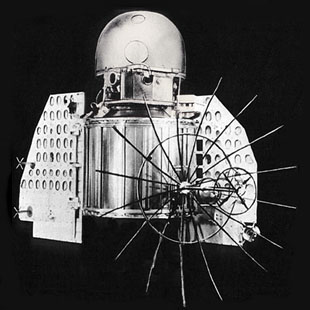 1VA (back)
1VA (back)
|
|
The 1V Venus project was scaled back. Instead of carrying a landing capsule with telemetry capability, a simplified 1VA vehicle would take measurements along its path, impact the planet, and deposit a
spherical pennant on the surface.
It would carry a complement of scientific experiments similar to 1M, but without a camera.
The 1VA vehicle used as much as possible of the 1M design. The cylindrical body topped by a dome was 1.05 meter in diameter and 2.035 meters tall, weighing 643.5 kilograms (1400 pounds). The body contained radio systems, telemetry tape recorder, the program timing unit and silver-zinc batteries charged by two square meters of solar cells (panels were 1.6 ×1 meters). It was sealed and pressurized with nitrogen to 1.2 atmospheres, with circulating fans to distribute heat. As on Sputnik-3 and Luna-3, motorized shutters on the back varied radiation of heat into space, stabilizing the temperature to around 30° C. The radio telemetry system onboard the probe was built by Riazanskii's design bureau. A parabolic antenna over 2 meters in diameter could transmit on a 8-cm and/or 32-cm band. It's reflector was a fine copper net (invisible in many photographs), which would open shortly before planetary encounter. Cross-shaped semi-directional antennas were mounted on the back of the solar panels, for low-bandwidth (probably 1 bit/sec) telemetry during flight on 922.8 MHz and telecommand reception. An omni-directional antenna was located at the end of a 2.4-meter boom, used during near-earth operation on a wavelength of 1.6 meters. Telecommands were sent on 770 MHz at 1/6 bit per second. The spacecraft's control system repeated commands and awaited an acknowledgement signal before execution. |
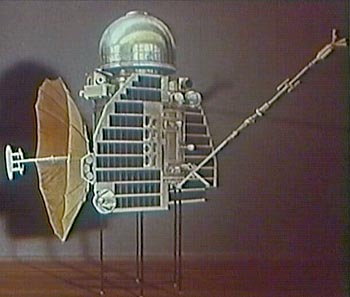 Venera-1
Venera-1
|
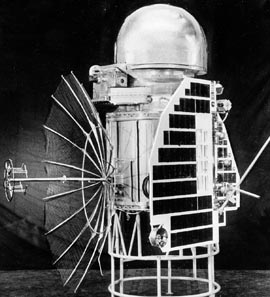 Venera-1 Side View
Venera-1 Side View
|
|
The attitude control system was designed by B.V. Raushenbakh. Solar and astral navigation sensors, using photomultiplier tubes, were designed by V.A. Khrustalëv at NPO Geofizika.
Gyroscopic sensors and accelerometers were built by V.I. Kuznetsov's bureau.
Like Luna-3, spacecraft orientation adjustments were performed with microjets, powered by compressed nitrogen.
The system consisted of several units for different modes of orientation.
The first mode to be engaged is a sun-finding that cancels out arbitrary spacecraft tumble and brings the ship close enough to solar orientation for the other attitude control units to work.
During most of the flight, the unit of constant solar orientation kept solar panels within 10° of perpendicular to the Sun, with minimal use of attitude control jets. In the event of a failure of the CSO system, sun finding and spin stabilization ("passive gyroscopic stabilization") was induced, at about 6 revolutions per hour. CSO was an uni-axial mode of orientation and permitted slow turning about the Solar axis. During telemetry sessions, a second orientation unit engaged to point the high-gain antenna. It performed a precision solar orientation within a few minutes of arc, then rotated around the solar axis until a second optical sensor locked onto the Earth. This was an improvement over 1M, which used radio signal strength to acquire the Earth. A third attitude control unit controlled mid-course corrections. It is impossible to launch a probe accurately enough to intercept another planet without a few trajectory corrections. This unit performed a precision solar orientation, and then rotated until a sensor acquired the bright southern star, Canopus or the star Sirus. Telecommands from Earth turned the Canopus sensor to a specified angle and set the velocity delta of the engine. The KDU-414 vernier engine was fueled by 1,1-dimethylhydrazine and red-fuming nitric acid. These ignite spontaneously when mixed, producing a thrust of 200 kgf (440 pounds). Specific hardware logic prevented the engine firing without a positive indication of star lock.
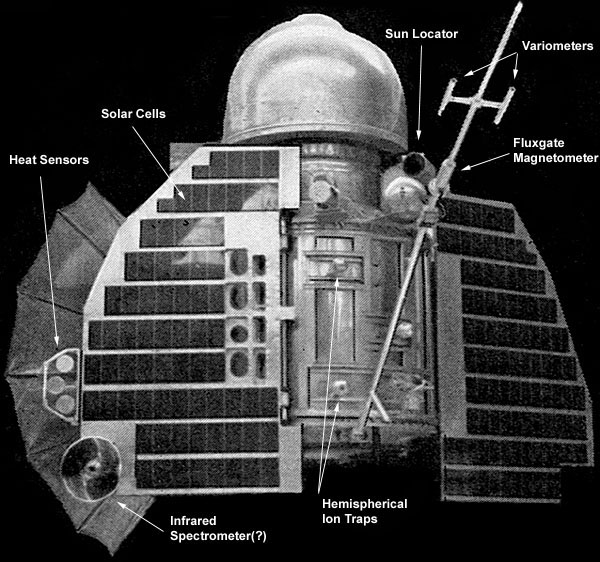
The onboard scientific experiments on the first Mars/Venus probes have never been precisely described, at least in known Western literature. Experiments that operated in deep space are well known, but the experiments designed for planetary encounter are more uncertain.
Detailed discussions of these types of remote sensors can be found here. The three small disk-shaped heat sensors were tests of the thermal properties of some materials during prolonged exposure to space and Solar radiation. The preceding Luna-3 mission and the following Mars-1 mission both contained a Cherenkov counter, and a "heavy nuclei detector" is described as a component of the 1M probe, so 1M and 1VA likely included such a device. The IR and UV spectrometers are mentioned, and certainly Lebedinskii had such devices on following missions. The Mars version of the IR detector was designed to verify the existence of the controversial "Sinton bands", signs of organic molecules reported from Earth-based spectroscopy. The Venus version of the IR detector may have been closer to the thermal-balance sensors Lebedinskii sent to Venus on later missions.
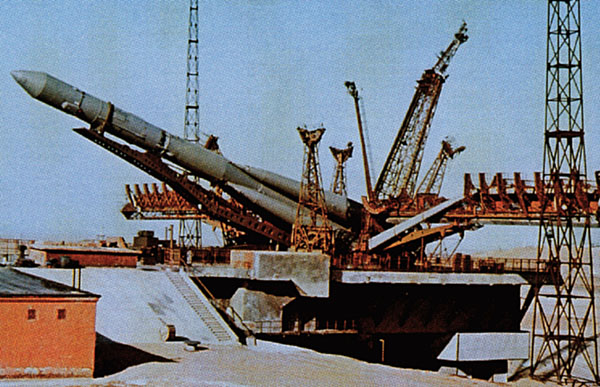 Preparing to Launch the 1M Mars Probe, Oct 10, 1960 The first 1VA probe was stranded in orbit on February 4 1961, when the escape stage failed. The 6483 kilogram fully fueled escape stage and probe were designated Sputnik-7. Its remains landed in Siberia, where the pennant was recovered. On February 12, Venera-1 was launched to Venus from the 6475 kilogram Sputnik-8 (after this, orbital escape stages were not classified as named satellites). This was the first successful launch-from-orbit maneuver and the first probe launched to another planet. It was planned to pass within 2,000-60,000 km of Venus. During the flight, recorded telemetry data would be transmitted every 24 hours during 90-minute sessions. On course to Venus, the sun locator in the system of constant solar orientation soon overheated and failed. The station was commanded to enter spin stabilization mode. The motorized thermal shutters also malfunctioned. Two scientific telemetry sessions were successfully carried out on the 12th, at a distance of 30,000 km and at 170,000 km. To save power, it did not attempt radio contact again for five days, and science data was successfully downloaded in a third telemetry session on the 17th, from a distance of 1,900,000 km. No further radio contacts succeeded, although the Jodrell Bank radio telescope in England assisted in trying to contact the probe until June of that year. It is estimated to have passed within 100,000 km of Venus that May. Venera-1 data on magnetic fields, cosmic rays and solar plasma have been published. The first telemetry session was planned to measure cosmic radiation at the magnetopause. "Solar wind" was first discovered by K.I. Gringauz with Luna-1 to Luna-3. Venera-1 was the first to verify that this plasma flow is present throughout deep interplanetary space. America's Pioneer/Able ProgramAmerica's first deep-space missions were the Pioneer/Able Lunar probes, launched with the small Able stage mounted on Juno, Thor or Atlas missiles, from 1958 to 1960. |
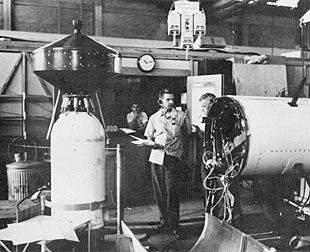 Pioneer-2
Pioneer-2
|
 Pioneer-5
Pioneer-5
|
|
Of nine missions, five failed completely, due to launch mishaps.
Lunar orbiter Pioneer-1 and lunar flyby probe Pioneer-3 experienced 3rd-stage failures, but reached altitudes of over 100,000 kilometers before falling back to Earth.
They returned distant space-radiation readings, and
Pioneer-1 became the second spacecraft to detect the outer radiation belt (after Sputnik-3).
The Pioneer-4 photo-flyby mission was the first American spacecraft to reach escape velocity, but it missed the Moon and took no pictures.
The only completely successful mission in this series was the 43 kilogram Pioneer-5 probe, launched into deep space on March 11, 1960. Pioneer-5 carried two radiation detectors, an induction magnetometer, and a micrometeorite detector (which malfunctioned). It transmitted telemetry at 1 to 64 bits/sec via omni-directional antennas. After one month, it was beyond the range of American telemetry systems, but Britain's Jodrell Bank radio telescope maintained contact. Telemetry data was discernable until the end of April, and a weak signal was detectable until the end of June, when it reached 36.2 million kilometers. Project 2MVWork began in February 1961 on a general Mars/Venus interplanetary spacecraft, code named 2MV. It would define the overall template for spacecrafts up to Venera-8. The craft consisted of an orbital module which could be joined with a descent capsule or a special instrument module. Four models were planned: 2MV-1 for Venus landing, 2MV-2 for Venus photo flyby, 2MV-3 for Mars landing, and 2MV-4 for Mars flyby.
 Mars-1, A Model 2MV-4 Photo Flyby Probe Seen above, the 893.5 kilogram Mars-1 spacecraft is probably identical to the Venus flyby model. It had a cylindrical body 1.1 meter in diameter, 3.3 meters long, with a 4-meter span across the solar panels. The course correction engine is seen at the top, and the special instrument module is at the bottom. The large middle section of the body, the orbital module, was a sealed compartment pressurized to 1.1 atm, containing radio, power and control logic systems. The craft was powered by 2.6 square meters of solar cells, generating 1.3 to 2.6 amps. These charged a bank of NiCd batteries with a 42 amp-hour capacity, so during planetary encounter or telemetry downloads, power consumption could exceeded solar cell output. An onboard tape recorder stored science and housekeeping data for periodic playback to Earth. The radio system could transmit via a 1.7 meter dish antenna on the 5-cm, 8-cm 32-cm bands used by the Pluton system. It received commands on 39-cm using semi-directional antennas. While close to earth, it used 1.6-meter band radio with the whip antennas attached to the solar panels. In fact, the optical parabolic-antenna pointing system cannot function until the Earth is small in the distance. In an emergency, semi-directional antennas could also transmit telemetry at a greatly reduced bit rate.
The above list of scientific sensors onboard Mars-1 is probably very similar to the Venus flyby missions. Different IR spectrometers were designed to investigate the CH-band at Mars and study the thermal balance of Venus. The IR spectrometer was mounted on the outside of the special instrument module, pointing in the same direction as the camera. Early micrometeorite detectors were isolated square piezoelectric panels, but on the 2MV and subsequent crafts, she attached sensors to the back of the solar panels, using a 1.5 square-meter area to count impacts. Housekeeping data was also transmitted on temperature, pressure, solar-cell current, etc. A ribbon antenna extended to measure 150 and 1500-meter radio wavelengths. A 32 kilogram camera system looked out through portholes on the end of the special instrument module. Pictures could be taken through a wide-angle (35mm) or telescopic (750 mm) lenses, and an ultraviolet spectrograph, for the study of the Martian ozone layer, could also project onto the film. The compartment contained a dedicated 5-cm wavelength impulse transmitter for image data. Up to 112 pictures were stored on film and scanned for playback to Earth. Soviet impulse transmitters sent extremely powerful signals in the form of very brief 25 kilowatt spikes. The average power consumption was 50 watts. It's image transmission rate was approximately 90 pixels/sec, using pulse-position modulation. |
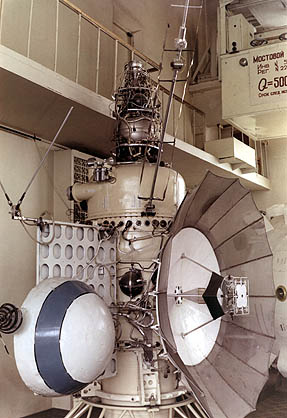 Mars-1
Mars-1
|
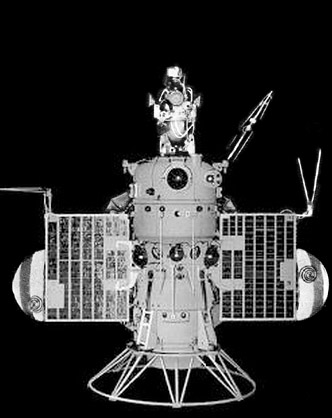 Mars-1
Mars-1
|
|
At one end of the craft was the KDU-414 vernier engine and attitude control microjets, using compressed nitrogen.
Like Venera-1, the craft had several orientation modes.
During flight, constant solar orientation mode maintained uni-axial orientation with solar panels facing within ±10° of the Sun. During telemetry downloads, it assumed precision three-axis orientation, optically locking onto the Sun and Earth to point the parabolic antenna.
Input from gyroscopic angular-velocity sensors were again used to provide motion damping.
Specialized orientation modes were designed for planetary photography, using sensors attached to the camera inside the special instrument module.
During mid-course corrections, precision orientation was relative to the Sun and the star Canopus, or alternatively, the spacecraft could be commanded to point the vernier engine directly toward or away from the Sun. The star angle and velocity delta were radioed from Earth and relayed back for verification. The orientation control system provided gyroscopic stabilization during engine burn, adjusting the angle of the vernier engine. Engines were turned off when the specified change in velocity was measured by integrating accelerometers. On the Venus probes, the KDU was designed for one correction of up to 14,000 kgf-sec. On the Mars versions, it was designed for two corrections totaling up to 8,000 kgf-sec. Several major design changes were motivated by lessons learned from Venera-1. The Sun, Earth and Star trackers were kept inside the pressurized temperature-controlled environment of the craft, looking out through a quartz dome. Troublesome motorized shutters were abandoned in favor of hemispherical thermal-control radiators. Coated with 40 layers of colored terylene plastic and powdered aluminum to absorb heat in some areas and radiate heat away in others. Ditolyl-methane circulated in the heating lines, and iso-octane in the coolant lines, both coupled by heat exchangers with the circulating nitrogen inside the spacecraft. Though rarely seen in photos, the cylindrical body of a spacecraft was covered with a blanket of thermal vacuum insulation consisting of layers of metal foil and fiberglass cloth. The temperature inside Mars-1 was maintained within 20° to 30° C.
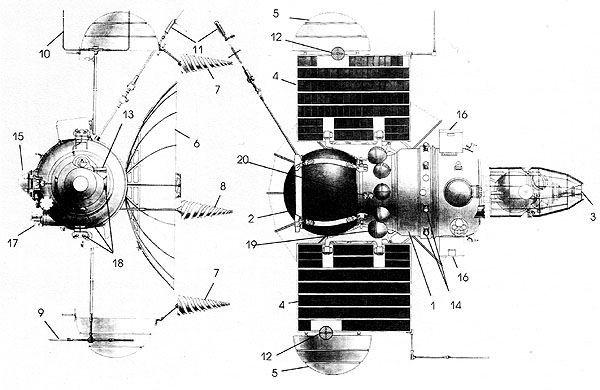
Venus Probe with Descent Capsule (model 2MV-1)
A.I. Lebedinskii and V.A. Krasnopol'skii built two experiments for the 2MV Venus lander in 1962. One was a 3×3 array of gas-discharge tubes, with the outer 8 acting as anti-coincidence shields. This would measure gamma radiation from the surface rocks, but eliminate cosmic-ray showers. The other was a mercury switch that detected capsule motion, in case of an ocean landing (the descent capsule would float). Both devices shared a common electronics block, which alternately recorded gamma-ray counts or motion counts. Three attempts were made to send model 2MV probes to Venus, during the 1962 launch opportunity. Landing missions (model 2MV-1) were launched on August 25 and September 1. A photo-flyby mission was launched on September 12. All three suffered failures of the escape stage and were stranded in Earth orbit. The most successful 2MV spacecraft was Mars-1. A faulty valve seal slowly leaked the compressed nitrogen supply for its attitude control, and it was put into spin stabilization mode before it lost its thrusters. The cause was verified by an identical test model of the spacecraft on Earth. The mishap highlights the importance of spacecraft housekeeping data, which allowed mission controllers to detect and react to the problem. Mars-1 was still able to perform space-radiation experiments, measuring the interplanetary magnetic field, detecting swarms of micrometeorites, and observing fluctuations in solar wind caused by eruptions on the Sun. Radio contact was maintained on via the decimeter-band semi-directional antennas, until reaching a record distance of 106 million kilometers, but contact was lost before it reached Mars. America's Mariner-2 |
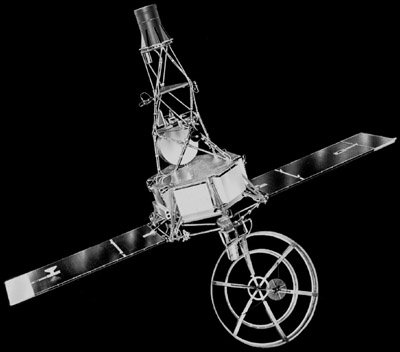 Mariner-2 (1962)
Mariner-2 (1962)
|
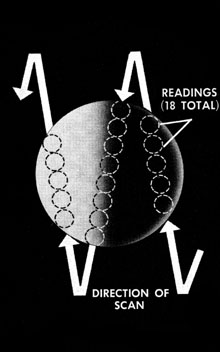 Radiometer readings
Radiometer readings
|
|
America launched the 203 kilogram Mariner-2 probe during this launch window, August 27, 1962.
A modified Ranger Lunar probe, it had an attitude control system, a parabolic high-gain antenna, and thermal-control shutters.
It was launched from a parking orbit, using an Atlas missile and an Agena escape stage,
and on December 14, it pass within 34,773 km of Venus.
Telemetry was sent from a distance of 87 million kilometers at 8 bits per second.
Mariner-2 discovered the Venusian magnetic field was very weak (below the threshold of its magnetometer), and it's radiometers detected limb darkening of thermal emissions at 1.9 cm wavelengths.
This evidence of the hot-surface model of Venus was highly convincing to most of the world's scientific community.
Mariner-2 was the first successful planetary probe.
To keep weight to a minimum, American spacecrafts were open to vacuum. Mariner's orientation systems kept constant high-gain antenna contact with Earth, sending data slowly and continuously. Soviet probes used fewer attitude-control resources by recording data and maintaining tight antenna lock only during periodic high-speed downloads. Mariner-2 came dangerously close to failing en route to Venus. One of its two solar panels shorted out, its attitude control system failed and recovered mysteriously, and the Earth-location sensor, which aimed the high-gain antenna, had faded to within a few percent of total blindness. However, the most serious problem was the spacecraft's inadequate thermal control system, a problem that also plagued early Soviet probes. By the time of planetary encounter, most of the temperature sensors on Mariner-2 were pegged at their maximum reading, and the spacecraft was over 100° C, far beyond the safe range for its electronics. Scientists at JPL joked that their acronym should stand for "just plain lucky". While the Soviets had been losing Moon landers and large planetary probes, the Americans were frustrated by 14 failed Lunar spacecrafts and the loss of Mariner-1. Ironically, they reached Venus two years before their first successful Moon probe, Ranger-7. Project 3MVDuring the mission of Mars-1 in late 1962, work began on an improved series of spacecrafts, the model 3MV. Six variants were planned:
The basic design remained: an orbital module filled with radio and control electronics was common to all models. Flyby missions had a special instrument module. Landing missions carried a spherical descent module. A collar between the orbital module and the special module, called a carrier ring, was used to mount some experiments. On Mars missions, compressed-nitrogen bottles were attached to the carrier ring. On Venus missions, they were attached to the cowling of the vernier engine. Most 2MV vehicles were destroyed by failures of the Molniia escape stage, but from their limited experiences, a number of changes were made. Small changes were made to the shape of the spacecraft, to adjust moments of inertia and solar-wind torques. |
 Older Model 2MV (Mars-1)
Older Model 2MV (Mars-1)
|
 Newer Model 3MV (Venera-3)
Newer Model 3MV (Venera-3)
|
|
Changes also included more redundancy in the attitude control system and transmitters. A thermal protection cowl around the KDU-414 vernier engine and fuel tanks were added, and a black shield between the star sensors and the craft to prevent interference from reflected light
(the shield may have only come into use after early 3MV tests).
The orbital module contained the 14-volt power system, including 112 amp-hours of NiCd batteries charged by the solar panels. It also contained 32-cm and meter-band transmitters, 39-cm and meter-band receivers, two stabilized crystal oscillators for subcarrier generation, two telemetry tape recorders, the attitude control system, commutation units, switches, etc.
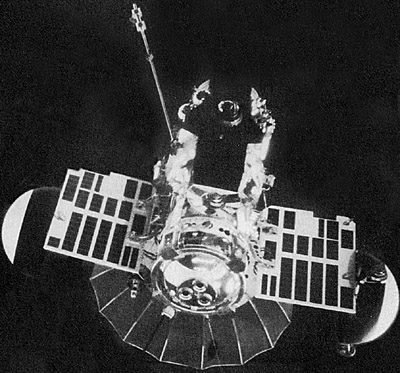
The special instrument module, for fly-by missions, contained a new camera system designed by A.S. Selivanov. It weighed only 6.5 kilograms and used 25.4 mm film. Redesign of the impulse transmitter and the modulation scheme increased image transmission time by a factor of 4 over the Mars-1 style camera. 40 pictures could be stored on the film and repeatedly rewound, by command, to be scanned and transmitted at several different speeds and resolutions. Note the three portholes at the end of the module, for cameras and spectrometers. The instrument module also contained a 5-cm impulse transmitter, an 8-cm continuous-wave transmitter (either of which could be used to send image data), a tape recorder which was part of Lebedinskii's IR spectrometer, and backup versions of the command receiver, program-timing unit, subcarrier oscillator and other electronics that can operate the mission in case of a serious failure in the orbital module. The 90-centimeter spherical descent capsules contained batteries, two 32-cm transmitters, program-timing units and two crystal oscillators. The Mars lander contained a tape recorder.
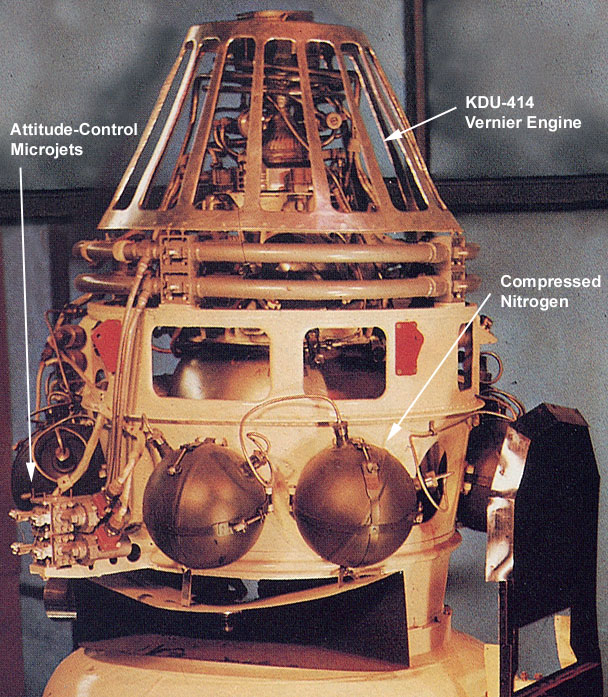 Venera-3 Vernier Engine and Attitude Control System The 200 kilogram-force (440-pound) vernier engine, KDU-414, was used by planetary probes from 1M to Venera-8. Designed by A.M. Isaev's bureau, the engine and fuel tank assembly is one meter long. For the 3MV missions, the KDU was outfitted and fueled for 2 corrective burns, with a maximum total impulse of 10,600 kgf-sec. The length of an engine burn is determined by an integrating accelerometer, cutting off the engine when a programmed velocity delta is achieved. The engine is mounted on steering gimbals, and a control system governed by an inertial gyroscope maintains a straight trajectory. The spherical bottles mounted on the engine cowl contained nitrogen gas at 320 atmospheres pressure. Reduced to 2 or 6 atm, it is fed to microjets producing pulses of thrust for the attitude control system. One advantage of using nitrogen jets instead of small liquid-fuel rocket motors was the lack of exhaust and ice crystals, which could interfere with the navigational star sensors. About 300 grams of nitrogen per month were expended to maintain normal spacecraft functions. 3MV Test FlightsA test launch of a 3MV-1A was made on November 11, 1963, with a plan to launch on a simulated Mars mission (the time was not right for a real trajectory opportunity to the planet). A failure of the escape stage left it stranded in orbit, and it was designated Kosmos-21. On February 19 1964, another 3MV-1A test was attempted to simulate the Venus flight plan. A third-stage engine failure prevented it from reaching orbit.These were light-weight test vehicles with no planetary-encounter experiments. They had plasma jets which were later tested on Zond-2 and Zond-3 missions. Experiments were included for testing mechanical friction of gears, materials and lubricants in space, also included on later Zond and Luna missions in preparation for the complex rover and sample-return missions. The also had the usual deep-space scientific experiments: sensors of cosmic-rays, solar plasma, micrometeorites, magnetic fields. The early test flights (but not the real planetary probes) were also reported to have solar x-ray/UV experiments, built by S.L. Mandel'shtam. It is not clear if a 3MV-4A vehicle was ever built. Some reports claim that Zond-2 and/or Zond-3 were 3MV-4A rather than 3MV-4, but the distinction may be meaningless. The actual missions launched probably all varied somewhat from the original plans in the above table of six 3MV models. Zond-2 contained some experiments planned for 3MV-4A (e.g. plasma jets), but it was also a real Mars mission, launched during a real trajectory opportunity. Mars probes were modified for Venus missions, etc. Zond-1Two Venus attempts were made in the late-March 1964 launch opportunity, both carrying descent modules (3MV-1). One launched on March 27 was stranded in parking orbit (Kosmos-27), but the second spacecraft, Zond-1, was successfully launched toward Venus on April 2. Shortly after takeoff, it began to lose pressure in the orbital module. From the slight thrust caused by the escaping gas, and subsequent spacecraft motion, it was determined that the leak was coming from the region of the quartz dome of the sun/star navigational sensor. The systems in the orbital module might have continued to function in a complete vacuum, but the radio switched on while there was still a rarified atmosphere in the compartment, and corona discharges damaged the electronics.The descent capsule retained pressure, and good back-up design allowed its transmitter to drive the spacecraft's telemetry system. Consequently, space science experiments were able to relay data, including cosmic ray measurements by Vernov's sensors in the orbital module, Lyman-α readings by Kurt's spectrometer, and primary proton measurements by Avdiushin's radiation detector in the descent capsule. Experiments on the spacecraft bus included: Experiments in the descent capsule included: The Zond-1 capsule was designed to land on the night side of Venus. A photometer sensitive from 0.001 to 10,000 lux with logarithmic encoding was designed by Lebedinskii and Krasnopol'skii to measure possible nighttime airglow. The anti-coincidence gamma-ray detector was similar to Lebedinskii's on the 2MV lander, but was also used to measure primary cosmic rays during the flight. The experiment described as "electrical conductivity of environment" might have been the electro-conductivity hydrometer later used in Venera-4's gas analyzer. Telemetry was received from April 2 to May 16. Two course corrections were made on May 14 at a distance of 13 million km, but an attempt to make a final correction on May 30 was unsuccessful, and contact with the probe was lost. It is sometimes speculated that Zond-1 could have impacted Venus, but Soviet experts believed it missed by 100,000 km. |
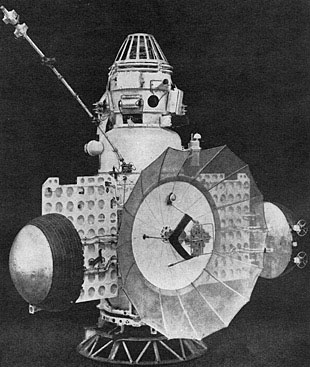 Zond-3
Zond-3
|
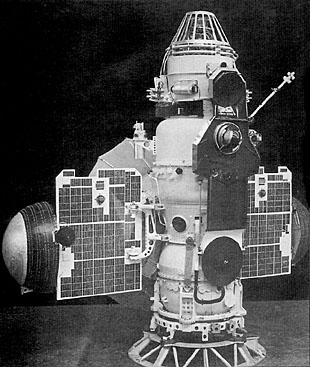 Zond-3
Zond-3
|
|
The most successful 3MV mission was Zond-3, a duplicate of the failed Zond-2 Mars probe.
Note that a Mars probe has a denser arrangement of solar cells than a Venus probe.
Zond-2 and Zond-3 tested
plasma pulse engines
(seen on both sides of vernier engine cowl) for attitude control, but also had the usual gas-powered micro rockets.
The plasma jets were no successful, but improved versions were later put into standard use.
The 960 kilogram Zond-3 performed a photo flyby of the Moon, taking 23 photographs and 3 ultraviolet spectra. It proceeded on a Mars trajectory, but not at a time when planetary encounter would occur. To test telemetry, the images were rewound and transmitted at 2.2 million km, 31.5 million km and possibly again at greater distances. The mission was ended and radio contact ceased when it was at a distance of 150 million km. Venera-2 and Venera-3In the Fall 1965 launch window, three more attempts were made, this time using repurposed 3MV-3 and 3MV-4 Mars probes. One was stranded in its parking orbit (Kosmos-96), but Venera-2 and Venera-3 were successfully launched on a trajectory to Venus. |
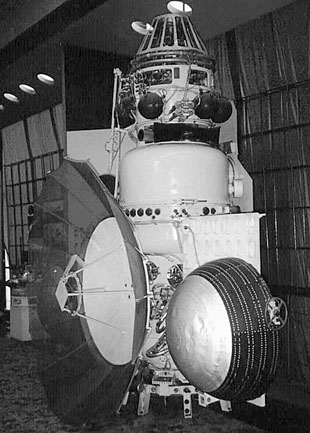 Venera-2
Venera-2
|
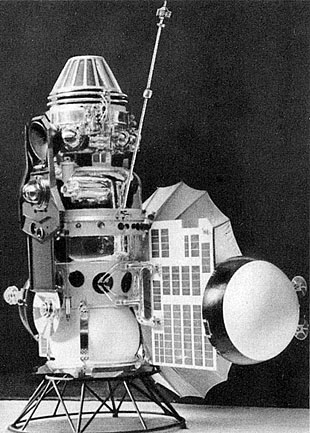 Venera-3
Venera-3
|
Launched on November 12, the 963 kilogram Venera-2 was a photo fly-by mission, almost identical to Zond-2 and Zond-3.
It's initial injection into an interplanetary trajectory was so precise that no mid-course corrections were required, and it passed within 24,000 km of Venus on February 27.
As it approached Venus, overheating began to cause problems with radio communication.
One report suggested the thermal radiator domes had been painted incorrectly.
After 26 radio communication sessions right up to the flyby of Venus, Venera-2 failed to respond to requests to download its planetary-encounter telemetry from the tape recorder.
Tragically, the spacecraft probably completed its scientific experiments and photography, but was unable to transmit the results to Earth.
Experiments on the spacecraft's main orbital module included:
And in the flyby instrument module: The camera system and ultraviolet spectrometers were identical to Zond-2 and 3. However, the infrared spectrometer was not the CH-band experiment designed for Zond-2; but rather, was a meteorological spectrometer to measure the atmosphere's thermal balance. The small decimeter-band radiometer dish antenna can be seen on the carrier ring in the Venera-3 and Zond-3 images. Venera-3, launched on November 16, was 960 kg and carried a 337 kg descent module. On December 26 it successfully executed a course correction that placed it on an impact trajectory, passing within 800 km of the center of Venus. 63 communication sessions took place with Venera-3, which may have functioned until planetary impact on March 1. Unfortunately, no telemetry was received from its descent capsule. Venera-3 was the first man-made object to fall on another planet, depositing a globe-shaped pennant and Soviet seals. It impacted on the night side of Venus, near the terminator, probably around -20º to 20º N, 60º to 80º E. The spacecraft's orbital module contained essentially the same experiments as Venera-2, except it had an extra SBT-9 external cosmic-ray sensor, and it did not have the micrometeorite and KHz radio experiments. The descent module included the third "spare" set of Venus experiments, prepared before the Zond-1 launch: A micro-organism detection experiment was planned for the 3MV Venus and Mars landers, but it was never deployed. If it was built, the likely designer would have been A.A. Imshenetskii of the Soviet Institute of Microbiology. At about this time, he wrote papers discussing the theoretical design of such a device, suggesting that a nutrient broth could be inoculated with soil. Metabolic activity in the broth could be detected by nephelometry (changes in cloudiness), manometry (pressure from generated gas) and changes in acidity. An experiment of this nature was performed by the American Viking lander on Mars in 1975, using manometry, but strong chemical reactions with the minerals in the soil obscured any signs of biological activity. What Did Scientists Expect To FindThe 3MV descent capsules were designed optimistically, with solar cells and an ammonia cooling system, in the hope they might survive for some time on the surface. They were built to survive modest pressures of 1.5 - 5 atm and temperatures of 57° - 77° C; and they were designed to float in water and detect the rocking motion of waves. One Soviet artist's conception, seen below, depicts Venus as an alien watery world. Modern Western accounts sometimes ridicule Russian scientists for considering these possibilities, so let us examine more closely what scientists knew about Venus in the early 1960s:
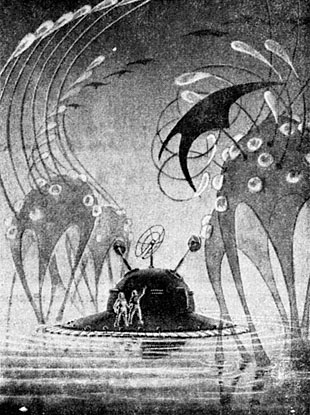
Venus is closer to the Sun, but its bright clouds reflect 70% of that radiation, leaving open the possibility that Venus might have an habitable climate. The thick cloud cover was often interpreted as a sign that Venus was a humid tropical world, although the spectroscopic search for water had produced conflicting results. In the early 1950s, American Nobel laureate Harold Urey calculated the surface temperature of Venus to be 53° C (127° F). In the late 1950s, an unusual radio spectrum was observed, indicating both high and low temperatures. Soviet radio astronomer A.D. Kuz'min was one of the first to discuss two alternate conditions on Venus: a hot surface/cool atmosphere or a hot ionosphere/cool surface. In America, two corresponding theories were proposed: Carl Sagan's greenhouse theory, and D.E. Jones' ionospheric theory. Both were consistent with the radio spectrum of Venus, but neither could reproduce it accurately without extreme assumptions. The chief theorist of the Soviet space program, M.V. Keldysh, asked for an investigation of conditions on Venus, in order to design the Venera landing modules. As in America, professional opinions varied. The astronomer V.I. Moroz advocated the hot surface theory, while nuclear physicist A.I. Lebedinskii initially supported the ionospheric model (but later changed his mind). In 1962, Soviet radio astronomer D.V. Korol'kov was the first to measure radio limb darkening of Venus, indicating a hot surface. In 1964, a more conclusive discovery of limb polarization by Clark & Kuz'min all but extinguished hope for a cool surface. At the time of Venera-3's launch, this was the official view, probably of Keldysh himself: "One of the most probable hypotheses is the assumption, that the surface of the planet is really heated up to 300-400° C due to intense "greenhouse effect" ... there are other assumptions, for instance, about [radio spectrum] generation due to the intensive motion of electrons in atmosphere or ionosphere."Keldysh reports that it was realized the surface of Venus was 400° C, but too late to rebuild the Venera-3 spacecraft. On Venera-4, ocean-wave motion detection experiments were omitted, and the capsule was strengthened to withstand harsher conditions. Its parachute (and probably also Venera-3's) could survive 400° C -- but still hedging their bets -- the capsule was designed to float.-- Pravda, March 6, 1966 |
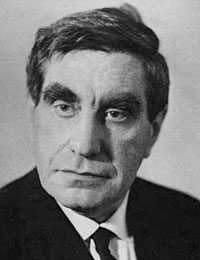 A.I. Lebedinskii
A.I. Lebedinskii
|
 G.Iu. Maksimov
G.Iu. Maksimov
|
 B.V. Raushenbakh
B.V. Raushenbakh
|
|
AcknowledgementsMany image are from NASA and come courtesy of their generous non-commercial usage policy. In particular, many are from the web site of David R. Williams, National Space Science Data Center, nssdc.gsfc.nasa.gov. The photograph of Venera-2 is courtesy of J. Porter Clark. The color movie frame of Venera-1 is courtesy of Vladimir V. Semenov of VideoCosmos.Thanks to Vladimir Krasnopolsky for his many comments and recollections about his experiments on early Venus probes and on his work with Lebedinskii. Thanks to Nikolai Kardashev, Nina Kuleshova, Vladimir Kurt, and Slava Slysh for help regarding early Venera probes and Experiments. |